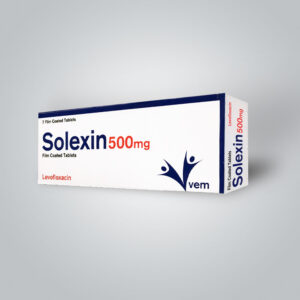 SOLEXIN coated tablets
SOLEXIN coated tablets
SOLEXIN
International non-proprietary name: Levofloxacin
Composition
Active substance: 1 tablet contains 512.46 mg of levofloxacin hemihydrate (equivalent to 500 mg of levofloxacin).
Excipients: microcrystalline cellulose, hydroxypropylcellulose, crospvidone, colloidal silicon dioxide, magnesium citrate, sepifilm LP 761 (HPMC, microcrystalline cellulose, stearic acid, titanium dioxide).
Description
They are biconvex oblong tablets with a pale yellowish-pink coating, with a dividing line on both sides.
Pharmacotherapeutic group
Antibacterial agent, fluoroquinolone.
ATC : J01MA12.
Pharmacological properties
Pharmacodynamics
Solexin is a broad-spectrum antibacterial agent from the fluoroquinolone group. Levofloxacin is an antibacterial agent from the fluoroquinolone group, it has a bactericidal effect by affecting DNA-gyrase complexes (bacterial topoisomerase II) and topoisomerase IV of bacteria. Levofloxacin is active against most microorganisms, acting both in vitro and in vivo. Aerobic gram-positive strains: Corynebacterium diphteriae, enterococcus faecalis, Staphylococcus aureus (methicillin-sensitive strains), Staphylococcus epidermidis (methicillin-sensitive strains), Staphylococcus saprophyticus, Streptococcus pneumoniae, Streptococcus pyogenes;
Aerobic gram-negative strains: Enterobacter cloacae, Escherichia coli, Haemophillus influenzae, Haemaphillus parainfluenzae, Klebsiella pneumoniae, Legionella pneumoniae, Moraxella catarrhalis, Proteus mirabilis, pseudomonas aeruginosa, Serratia marcescens; Other microorganisms: Chlamydia pneumoniae, Mycoplasma pneumoniae. Anaerobic gram-positive: Clostridium perfringens. Pharmacokinetics
Levofloxacin is rapidly and completely absorbed after oral administration. The maximum concentration in the blood plasma is reached 1-2 hours after oral administration. Absolute bioavailability is about 99%. The pharmacokinetics of levofloxacin are linear and predictable with single or repeated oral or intravenous dosing regimens. Stable concentrations are achieved 48 hours after taking a dose of 500 mg per day. Solexin coated tablets are recommended to be taken 1 hour before or 2 hours after food intake, as co-administration of levofloxacin at a dose of 500 mg with food prolongs the time to reach the maximum concentration by 1 hour, and the maximum plasma concentration after taking the tablets is 14% after taking the oral product. 25% decrease. Since the pharmacokinetics of Levofloxacin are similar and comparable during oral and intravenous administration of the same dose, it is possible to switch from one drug form to another. Levofloxacin is stereochemically stable in plasma and urine and is not metabolically converted to its enantiomer. After oral administration, 87% of the injected dose is excreted unchanged in urine within 48 hours, and 4% of the dose is excreted in feces within 72 hours. Levofloxacin is metabolised to an insignificant extent and is mainly excreted unchanged in the urine. Levofloxacin has a half-life of approximately 6-8 hours after oral and intravenous administration of single and repeated doses.
Instructions for use
Haemoritis of the stomach.
Exacerbation of chronic bronchitis.
Community-acquired pneumonia.
Complicated infections of the urinary system, including pyelonephritis.
Skin and soft tissue infections.
Contraindications
Hypersensitivity to levofloxacin or other antibacterial agents from the quinolone group, as well as any of the auxiliary substances included in the preparation. Epilepsy. Tendon damage previously associated with the use of antibacterial agents from the fluoroquinolone group.
Use in children and adolescents.
Pregnancy and lactation period
Special instructions and precautions
Combination with other antibiotics may be required in nosocomial infections caused by P. aerugenosis. Treatment-related pseudomembranous enterocolitis with Clostridium difficile should be considered if severe persistent or bloody diarrhea occurs during or after treatment. If this is suspected, treatment with Solexin coated tablets should be stopped immediately and appropriate supportive or specific treatment should be started without delay. In this clinical situation, drugs that slow intestinal peristalsis are contraindicated. During the use of antibacterial agents from the fluoroquinolone group, tendinitis is rarely possible, and in some cases – rupture of the Achilles tendon. This unpleasant manifestation can appear 48 hours after the onset of the illness and can be bilateral. The risk of tendinitis and tendon rupture is higher in elderly patients and people taking corticosteroids. Therefore, it is important to observe such patients during the use of Solexin coated tablets. If tendinitis is suspected, treatment with Solexin coated tablets should be stopped immediately and appropriate treatment (i.e., immobilization of the damaged tendon) should be initiated. As with other fluoroquinolones, Solexin-coated tablets should be used with caution in patients prone to seizures associated with previous head injury, with fenbufen or similar nonsteroidal anti-inflammatory drugs, or with anticonvulsant drugs such as theophylline.
It should be used with caution in patients with glucose-6-phosphate dehydrogenase deficiency, as there are reports of hemolytic reactions during the use of quinolone antibacterial agents in this group of patients. In case of renal failure, the dose of Solexin coated tablets is adjusted taking into account creatinine clearance. Although photosensitivity is very rarely observed during the use of levofloxacin, patients are not recommended to be exposed to strong sunlight or artificial ultraviolet light such as solariums.
Some of the side effects observed during treatment with Solexin coated tablets may impair the ability to concentrate and the ability to react, which may constitute a certain risk, especially in driving vehicles and operating machinery.
Oral hypoglycemic agents at the same time as during the use of other quinolones
(glibilud / glibenclamide) or in patients with diabetes using insulin, changes in blood glucose levels, including symptomatic hyper- or hypoglycemia, have been reported. Blood glucose levels should be carefully monitored in these patients. If a hypoglycemic reaction occurs in patients treated with Solexin, the treatment should be stopped immediately and appropriate treatment should be instituted.
Serious and sometimes fatal hypersensitivity reactions or anaphylactic shock have been reported during treatment with quinolones, including levofloxacin. Such reactions often appear after the first dose. Some reactions can be observed together with cardiovascular collapse, hypotension \ shock, convulsions, loss of consciousness, burning sensation on the skin, angioneurotic edema, shortness of breath, hives, itching and other serious reactions. At the first appearance of skin rash or other symptoms of hypersensitivity, treatment with levofloxacin should be stopped immediately. In severe acute hypersensitivity reactions, epinephrine, as well as intravenous oxygen products, antihistamines, corticosteroids, pressor amines, and other resuscitative measures are initiated.
As during treatment with other antibiotics, especially long-term use of levofloxacin can lead to an increase in resistant microorganisms. Accordingly, the patient’s condition is taken into account during re-treatment. Appropriate measures should be taken if superinfection occurs during treatment. Levofloxacin may cause QT prolongation syndrome or Torsades de Pointes during treatment. Do not use if congenital QT interval prolongation or Torsades de Pointes is diagnosed or suspected.
Interaction with other drugs
Antacids, sucralfate, iron salts, multivitamin preparations. Compared to other quinolones, complex formation with divalent cations is less, but simultaneous use of Solexin coated tablets with iron salts, sucralfate, metal cations (such as iron) and zinc-containing multivitamin preparations, Mg- and Al-containing antacids may adversely affect the absorption of levofloxacin from the gastrointestinal tract. and may lead to higher than expected concentrations. It is recommended to take preparations containing these substances 2 hours before or 2 hours after taking Solexin coated tablets.
Method of use and dosage
Solexin coated tablets are taken 1 or 2 times a day. The dose is adjusted depending on the type of infection, severity and sensitivity of the suspected pathogen. The duration of treatment depends on the course of the disease. Solexin coated tablets are taken inside without chewing, with enough liquid. It is allowed to divide the tablets if there is a need for dose correction. Tablets can be taken 1 hour before or 2 hours after food intake. In order to prevent a decrease in the absorption of Solexin coated tablets, the tablets should be taken 2 hours before or 2 hours after taking iron salts, antacids or sucralfate. Dosage regimen in patients with normal renal function (creatinine clearance > 50 ml/min)
Doza həddinin aşılması
Expected symptoms of an acute overdose of solexin-coated tablets are manifested by the central nervous system in the form of confusion, dizziness, loss of consciousness and epitutum, and by the gastrointestinal system in the form of nausea and erosion of the gastric mucosa. Prolongation of the QT interval was noted during clinical pharmacology studies with supra-therapeutic doses of levofloxacin. In case of overdose, the patient should be under strict supervision and symptomatic treatment should be carried out. In case of acute overdose, gastric lavage can be considered. Antacids can be used to protect the stomach lining. Levofloxacin is not removed by hemodialysis, peritoneal dialysis and permanent ambulatory peritoneal dialysis. There is no specific antidote.
Release form: Soleksin 500 mg coated tablets. 7 tablets, in a blister. 1 blister is packed in a cardboard box together with a leafle.
Packing form
7 tablets, in a blister. 1 blister is packed in a cardboard box with an insert.
Storage conditions
It should be stored at a temperature not higher than 25 ºС, in its own box, in a dry place and out of the reach of children.
Shelf life
2 years.
Do not use after the expiration date.
By prescription.
Manufacturer
VEM İLAÇ San. ve Tic. A.Ş.Turkey
Çerkezköy Orqanize Sanayi Bölgesi.
